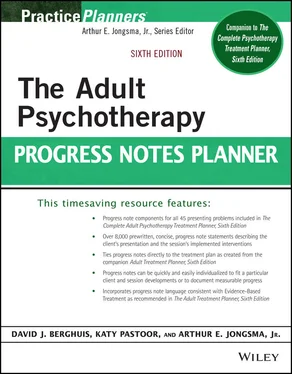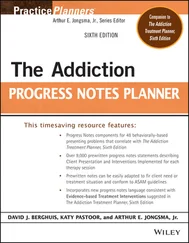23 Coordinate Group Psychoeducational Program (23)The client was admitted to a group psychoeducational program that teaches clients the psychological, biological, and social influences in the development of BPD.The client's involvement in the group psychoeducational program focused on the bio- logical and psychological treatment of his/her/their disorder.The client has followed through on his/her/their involvement in a group psychoeducational program and key topics were reviewed.The client has not followed through on his/her/their involvement in a group psychoeducational program and was redirected to do so.
24 Teach Illness Management Skills (24)The client was taught about illness management skills.The client was taught about identifying early warning signs, common triggers, and coping strategies.The client was taught about problem solving regarding life goals, and development of a personal care plan.The client was assigned “Identifying and Handling Triggers” in the Adult Psychotherapy Homework Planner (Jongsma).The client was assigned “Recognizing the Negative Consequence of Impulsive Behavior” in the Adult Psychotherapy Homework Planner (Jongsma).
25 Use Cognitive Therapy Techniques (25)Cognitive therapy techniques were used to identify, challenge and, change cognitive appraisals that may trigger his/her/their elevated or depressive mood.The client was reinforced for his/her/their greater insight into his/her/their cognitive appraisals.
26 Assign Homework on Cognitive Biases (26)The client was assigned homework exercises in which he/she/they identified cognitive biases in appraising self, others, and the environment.The client was assigned “Journal and Replace Self-Defeating Thoughts” in the Adult Psychotherapy Homework Planner (Jongsma).The client was assisted in reviewing his/her/their insight regarding cognitive biases, and his/her/their successes were reinforced.The client was provided with corrective feedback toward improvement of his/her/their understanding of cognitive biases and alternatives.
27 Teach Coping and Relapse Prevention Skills (27)The client was taught coping and relapse prevention skills via cognitive-behavioral techniques.The client was taught about delaying impulsive actions, structuring and scheduling daily activities, keeping a regular sleep routine, avoiding unrealistic goals striving, and using relaxation procedures.The client was taught about identifying and avoiding episode triggers.
28 Conduct Family-Focused Treatment (28)The client and significant others were included in the treatment model.Family-Focused Treatment was used with the client and significant others as indicated in Bipolar Disorder: A Family-Focused Approach (Miklowitz and Goldstein).As family members were not available to participate in therapy, the Family-Focused Treatment model was adapted to individual therapy.
29 Assess and Educate About Aversive Communication (29)The family was assessed for the role of aversive communication in family distress and in the risk for the client's manic relapse.The family was educated about the role of aversive communication (e.g. highly expressed emotion) in developing greater family stress and in increasing the client's risk for manic relapse.The family displayed a clear understanding of the effects of aversive communication, and this was reinforced.The family was provided with remedial feedback, as they did not display a clear under- standing of the risk for relapse due to aversive communication.
30 Teach Communication Skills (30)Behavioral techniques were used to teach communication skills.Communication skills such as offering positive feedback, active listening, making positive requests for behavioral change, and giving negative feedback in an honest, respectful manner were taught to the client and family.Behavioral techniques were used to teach the family healthy communication skills.Education, modeling, role-playing, corrective feedback, and positive reinforcement were used to teach communication skills.
31 Teach Problem-Solving Skills (31)Behavioral techniques such as education, modeling, role-playing, corrective feedback, and positive reinforcement were used to teach the client and family problem-solving skills.Specific problem-solving skills were taught to the family, including defining the problem constructively and specifically, brainstorming options, evaluating options, choosing options, implementing a plan, evaluating the results, and reevaluating the plan.Family members were asked to use the problem-solving skills on specific situations.The family was reinforced for positive use of problem-solving skills.The family was redirected for failures to properly use problem-solving skills.
32 Assign Problem-Solving Homework (32)The client and family were assigned to use newly learned problem-solving skills and record their use.The client and family were assigned “Plan Before Acting” or “Problem-Solving: An Alternative to Impulsive Action” in the Adult Psychotherapy Homework Planner (Jongsma).The results of the family members' use of problem-solving skills were reviewed within the session.The successful use of problem-solving skills by the client and family members was strongly reinforced.
33 Develop Relapse Drill (33)The client and family were assisted in drawing up a “relapse drill,” detailing roles and responsibilities.Family members were asked to take responsibility for specific roles (e.g. who will call a meeting of the family to problem-solve potential relapse; who will call the physician, schedule a serum level, or contact emergency services, if needed).Obstacles to providing family support to the client's potential relapse were reviewed and problem-solved.The family was asked to make a commitment to adherence to the plan.The family was reinforced for their commitment to adherence to the plan.The family has not developed a clear commitment to the relapse prevention plan and was redirected in this area.
34 Conduct Interpersonal and Social Rhythm Therapy (34)An assessment was conducted of the client's daily activities using an interview and the social rhythm metric.Information from the interview and social rhythm metric helped to conduct interpersonal and social rhythm therapy.
35 Establish Routine Daily Activities (35)The client was assisted in establishing a more routine pattern of daily activities.The client was assigned “Keeping a Daily Rhythm” in the Adult Psychotherapy Homework Planner (Jongsma).The client was assisted in identifying a routine pattern of sleeping, eating, solitary and social activities, and exercise.A form was developed to help review and schedule activities.An emphasis was placed on creating a predictable rhythm for each day.
36 Teach About Sleep Hygiene Practices (36)The client was taught about the importance of good sleep hygiene.The client was assigned the “Sleep Pattern Record” from the Adult Psychotherapy Homework Planner (Jongsma).The client's sleep pattern was routinely assessed.Interventions for the client's sleep pattern were provided, as he/she/they have been noted to have a dysfunctional sleep pattern.
37 Promote Behavioral Activation (37)The client was assisted in listing activities that he/she/they have previously enjoyed but not engaged in since experiencing the loss.The client was encouraged to re-engage in enjoyable activities.The client was assigned “Identify and Schedule Pleasant Activities” from the Adult Psychotherapy Homework Planner (Jongsma).The client's experience of reactivating previously enjoyed activities was processed.Care was taken to be certain not to overstimulate the client.The client was reinforced for initiating and maintaining a balanced level of activity and rest.
38 Conduct Interpersonal Portion of Therapy (38)The interpersonal component of the interpersonal and social rhythm therapy techniques was initiated.An assessment was completed of the client's current past significant relationships, including themes related to grief, interpersonal role disputes, role transitions, and skill deficits.The client was supported as he/she/they reviewed concerns related to interpersonal relationships.
Читать дальше












